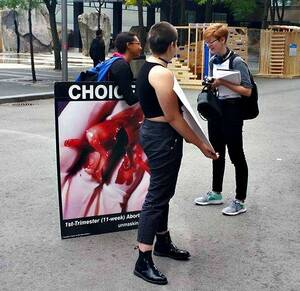PBA120H: How to Effectively Dialogue About Pre-Born Human Rights

- Bridging the Gap
- Three-question apologetic
- Practice conversations
- Demo
- Pairs
- Small group conversations and critique
Integrating Head, Heart, and Hands: The Ambassador Model
According to Aristotle, effective communicators need to have ethos (credibility/character), pathos (empathy), and logos (logic). Roman Catholic Archbishop of Toronto, Cardinal Thomas Collins, puts it this way: we need to build a bridge (ethos), touch the heart (pathos), and then and only then can we effectively deliver the message (logos). If all we have is an argument, no one will want to listen.
 Another way to think about this is through Stand to Reason’s ambassador model. To be effective pro-life ambassadors, we need:
Another way to think about this is through Stand to Reason’s ambassador model. To be effective pro-life ambassadors, we need:
- Knowledge (logos/head), an accurate mind — We should employ reason and provide compelling evidence for our positions.
- The purpose of the pro-life classroom is to equip you with the knowledge needed to make an airtight pro-life case against abortion. Wondering how to respond to the claim that a pre-born child is "just a fetus"? Not sure how to respond to the claim that abortion is medically necessary to save a woman's life? Want to learn more about embryology, philosophy, or the law? The pro-life apologetics on this site are here to help!
- Wisdom (pathos/heart), an artful method — We need to know how to communicate the knowledge we have.
- An ambassador will listen with the intent to understand, which means listening closely to what the other person is saying, and to what is not being said but is still being communicated. By hearing what the other person is really saying, the wise communicator will better know how to respond.
- Character (ethos/hands), an attractive manner — Everything we say and how we say it is complimented by who we are, so that if we talk about respect, we need to show respect, and if we talk about love, we need to show love. We need to know when to challenge people, and when to stop and listen to a person who is in pain.
Abortion advocates may ask a question that is designed to make the pro-lifer defend herself. (Here are several examples from Jen Bundock) It is important for the pro-lifer to remember the abortion advocate supports killing innocent children and that’s the position that should be challenged. A wise pro-life apologist will avoid getting distracted by tangential issues brought up by an abortion-advocate, and will re-focus the debate on the primary issue at hand: the killing of pre-born children.
Here is a dialogue example from when the local media in St. Catharine's reported on CCBR's demonstrations in the city. Devorah Gilman responded proactively rather than reactively to a question from an abortion supporter:
“[Nicole] McDowell, who said she cares for foster children, also asked [Devorah] Gilman how many foster children she was raising. 'Whether I personally adopt or foster children, can I not still speak out on behalf of the most vulnerable Canadian children that are being slaughtered?' said Gilman.”1)
For more examples of how to be proactive rather than reactive, check out this blog post from another CCBR staff member.
Show, Don't Tell
How do we communicate our knowledge about abortion in a way that combines wisdom and character? How can we communicate in a way that will actually reach people's hearts and minds?
 Imagine, for a moment, that you are back in your high school math class. Your teacher has just assigned you an algebra problem for homework. He assures you that it's an easy question, but it doesn't look easy to you–it looks like there are many variables which must be considered. You're not sure what the answer is, or how to even get to the answer.
Imagine, for a moment, that you are back in your high school math class. Your teacher has just assigned you an algebra problem for homework. He assures you that it's an easy question, but it doesn't look easy to you–it looks like there are many variables which must be considered. You're not sure what the answer is, or how to even get to the answer.
Now imagine that you ask two of your classmates for help. One friend confidently declares, “The answer is five.” The other friend shoots back, “No, it's not. The answer is 12.” Back and forth, they repeat their contrasting answers. Who do you believe? At that moment, you don't have a good reason to believe either of them. They have simply given you answers without showing you how they got to those answers, and you have no way of knowing whether either of them is correct. This is why any good math teacher tells students to “Show their work.”
What if, instead of asserting an answer, your first friend takes out a sheet of paper and works out the problem with you, step by step? Now would you believe her? Yes, because she has shown you how she got to that answer. Now you can understand the problem, and the answer, for yourself.
The principle that applies to math-tutoring also applies to pro-life dialogue: Show, don't tell. We need to give people reasons and compelling evidence for our views, rather than simply stating conclusions. We need to guide people to the truth so that they will understand and accept it for themselves. We can show people the truth, rather than simply telling them, by asking questions, telling stories, and presenting evidence.
Ask Questions
One of the most important aspects of pro-life dialogue is asking questions. Asking questions is important for several reasons: it shows you care and are willing to hear what the other person has to say; it keeps the other person in the conversation; and it forces the individual to explain his or her beliefs.
“Questions have power. They can set us on a journey looking for answers we previously didn't know. Or, they can draw out of us answers that, deep down, we did know but hadn't acknowledged until the opportunity arose from a question.” 2)
Questions make people think. They make the wheels start turning in someone's head. We may not have an hour to dialogue with every person about abortion–in the context of pro-life activism such as “Choice” Chain, we may only get a few minutes to speak with someone. This is why we open our conversation with a question, such as, “What do you think about abortion?” By asking people compelling questions, people will have to think more deeply about the abortion issue and about their own views on it.
“I once dialogued with a university student who, when asked what he thought about abortion, said he supported it. I asked a follow-up question and he declaratively said, 'I have news for you–they're not alive.' So I asked another question: 'Then why would a woman have an abortion?' He paused, clearly not expecting that, and said, 'Good point. Hold on, hold on, I have to go soon but I'll talk for a bit because it's rare to find someone who can think intelligently.'” - Stephanie Gray 3)
Tell Stories
Stories are powerful because people can relate to stories. Stories paint a picture in people's heads so that they can see how a concept plays out in reality. By using stories, analogies, and vivid descriptions, we can help people understand concepts that seem abstract or unfamiliar.
“Tell stories to reach people’s hearts and minds. Brain scans reveal that stories stimulate and engage the human brain, helping the speaker connect with the audience and making it much more likely that the audience will agree with the speaker’s point of view.” - Carmine Gallo4)
For instance, some people can have a hard time grasping the reality that the single-celled zygote produced through fertilization is a human being. How can something so very small, and something that looks very different from a born human, be equal to you and I? Using an analogy called “the Polaroid analogy” can help people to understand this concept better:
Insert Tikvah's story
Give Evidence
One of the reasons that we use abortion victim photography in all of our projects is because the images present compelling evidence against abortion. They communicate instantly the humanity of the pre-born and the inhumanity of abortion. By using these images when we dialogue with people, we can ground our conversations in the reality of what abortion does–in the reality of what kind of “choice” we're talking about.
After about another ten minutes of engaging in discussion, he brought up the image, and said: “You’re a smart guy with great arguments, but nothing you said to me compares to the power of that image you showed me. I can’t forget that. I think if you want to draw awareness to the reality of abortion, you should be doing more of that. If people see this, they won’t be so quick to abort their children.” - Western University student, to Gerrit Van Dorland, after seeing an image of an abortion victim
The Three Types of People We Encounter
Educating the Ignorant
Some people are simply ignorant concerning the truth about abortion, or support it without critically thinking about the issue. By presenting the truth to them in a compelling way, we can often see them shift their views right in front of us–if not change their minds completely. By showing images of abortion victims and by communicating the humanity and human rights of the pre-born, we can educate the uninformed and the misinformed.
Loving the Wounded
“Whom you would change, you must first love, and they must know that you love them.” - Martin Luther King Jr.
Although the pro-life position is simple and logical, some people will not be persuaded by the most rational arguments and evidence. Some people remain hostile or closed-off. Often, when no argument is getting through to an individual, it may be that he is not ignorant of the truth–rather, he doesn't want to know the truth. He is in denial. In other words, the problem is not in his head–but in his heart.
With Canada’s history littered with the corpses of over 4 million pre-born children, we shouldn’t be surprised. We are bringing a difficult truth to a deeply wounded culture. A whole lot of people we speak with aren’t merely defending a pro-abortion worldview in theory; they are defending their very selves, or their loved ones—their pasts, their deadly choices. When ignorant persons hears a pro-life argument, they are enlightened–a reaction of the head. But when those in denial hear a pro-life argument, they are agitated–a reaction of the heart. This different reaction necessitates a fundamentally different response.
It is here where the pro-lifer must learn to master the art of branching from the head to the heart. “Head” questions ask what someone believes, but heart questions ask why someone believes what they believe. Because heart apologetics are such a significant (and at times complex) part of pro-life dialogue, we have an entire section dedicated to heart apologetics. However, pro-life advocates should keep this over-arching principle in mind: Seek to understand.
- Ask gentle, open-ended questions.
- “Head” questions ask what someone believes, but heart questions ask why someone believes what they believe.
- Listen well.
- Listen with the intent to understand–not with the intent to respond.
When we seek to understand, we can give the other person a chance to open her heart, a chance to be listened to; and if the person brings up the difficult experiences that have led her to support abortion, we can address those experiences and help the person to accept the truth.
“Case in point—my colleague Maaike recently shared this testimony about the Genocide Awareness Project (GAP) when it was displayed at the University of Lethbridge last fall:
 'In one conversation, a pro-life student went to the heart of the matter when an angry protester defended her right to abortion. The protester had already heard our apologetics from another volunteer, talking for about 45 minutes. Then the protester turned to the pro-life student when the pro-lifer asked her why she felt she needed to defend abortion. It turned out that the protester had been abused by her dad and her mom didn’t do anything; she said she would never put a baby in a similar situation. The GAP volunteer expressed sympathy and affirmed the woman's value. They then talked about abortion, and the volunteer asked how killing her own child would improve the situation/cycle of abuse. After about 30 minutes the woman said no one had ever told her that she deserved to be loved by her own parents. She then rolled up her sign and left.'
'In one conversation, a pro-life student went to the heart of the matter when an angry protester defended her right to abortion. The protester had already heard our apologetics from another volunteer, talking for about 45 minutes. Then the protester turned to the pro-life student when the pro-lifer asked her why she felt she needed to defend abortion. It turned out that the protester had been abused by her dad and her mom didn’t do anything; she said she would never put a baby in a similar situation. The GAP volunteer expressed sympathy and affirmed the woman's value. They then talked about abortion, and the volunteer asked how killing her own child would improve the situation/cycle of abuse. After about 30 minutes the woman said no one had ever told her that she deserved to be loved by her own parents. She then rolled up her sign and left.'
No one had ever told her that she deserved to be loved by her own parents.
When we seek to understand, we find ourselves amidst profoundly beautiful opportunities to build up the brokenhearted, and to love them—to desire the other’s good—in a way that the abortion advocate least expects yet most needs to hear.” - Stephanie Gray
Inspiring the Apathetic

https://www.torontoagainstabortion.org/2018/05/21/adoption-suffering-and-love-reflections-of-a-powerful-conversation-on-a-rainy-day/ - shifting someone's perspective
https://mariamccann.ca/2023/02/10/the-truth-is-a-light-in-the-darkness/ sharing “D=S-M” in conversation to inspire the hopeless
Role-Playing
Role-play is a critical part of dialogue.
